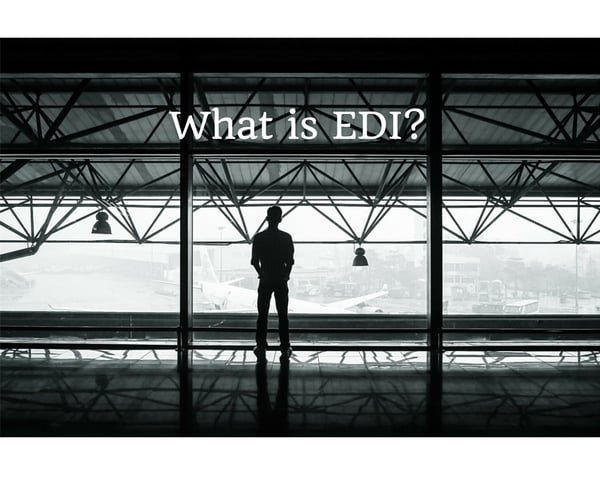What EDI Is And Why It's Easier To Implement Than Ever Before

Overview: What EDI Is
Although already in existence for about 40 years, EDI is not yet as widespread as it ought to be. But recent technological advancements and favorable business conditions are changing that.

What is EDI (Electronic Data Interchange)?
EDI or Electronic Data Interchange is a method of exchanging standardized business documents. By adhering to a common standard, two trading partners can seamlessly carry out business transactions despite initially having interoperability issues.
Here's an easy way to understand what EDI is.
Let's say you manage a manufacturing company and you do business with a certain supplier. Your transactions involve a boatload of business documents, including purchase orders, price catalogs, invoices, advance ship notices, shipping schedules, warehouse shipping orders - the whole nine yards.
Being in the digital age, both you and your trading partner already have IT systems in place and all business documents are generated through them. But the documents are in printed form.
To incorporate the data printed on these documents into your respective IT systems, both you and your trading partner have personnel in charge of data entry. Sadly, these manual data entry processes are tedious, time consuming, and prone to errors.
It would be so much easier if everything was automated. Picture this scenario:
The documents are purely in digital form and transmitted over a network. Upon arrival at the trading partner's side, all relevant data is automatically extracted from the documents and then incorporated into the target system. Surely, with all the latest developments in IT, something like this can't be hard to implement.
It is. Because you and your trading partner would normally have different ways of doing things, your documents would have syntactical, contextual, and structural differences that can complicate matters.
That wouldn't be too much of a problem when you have a human being who can easily deduce from not-so-subtle differences - the placement of certain pieces of information on a document, abbreviations, date formats (e.g. MMDDYY vs MMDDYYYY), decimal places, and so on. But for a computer, even slight deviations from what it expects can cause serious problems.
To avoid these types of problems, documents must strictly adhere to certain rules or standards that govern data structure, placement, format, and so on.
That's what EDI is all about. EDI is all about adhering to standards when exchanging electronic business documents. When two trading partners adhere to an EDI standard, automation can be easier to implement because their respective IT systems would know exactly what data should be included in a particular document, where in the document certain data should be placed, and what format they should be in.
EDI standards
There are actually several EDI document standards in use today. Some are industry-specific. Others, geographical. SWIFT, for instance, is used by the financial and banking industries. HIPAA EDI (based on X12) is specific to the US healthcare industry. ANSI ASC X12 is only widely used in the US. In Europe, the popular standard is EDIFACT.
Other standards in use include: EANCOM, ODETTE, RosettaNet, Tradacoms, VDA, and VICS.
What's important really is for you and your trading partner to agree on one standard.
Benefits of using EDI
Because EDI is designed to enable automated business transactions, it helps companies:
Eliminate human errors
When manual or semi-manual methods of transaction are used, data has to be inputted and re-inputted a number of times, making them prone to human errors. Erroneous data involving wrong products, quantities, prices, shipping information, or customer information can have serious and costly consequences. Automation mitigates that risk.
Improve efficiency
In an automated environment devoid of human errors, time normally spent correcting errors, re-transmitting business documents, or reconciling misaligned data can be allocated to more productive tasks. That means, more can be accomplished at the end of the day.
Save on costs
Traditional B2B transaction methods require stacks of paper, substantial storage space, and several personnel. They also entail filing, postage, storage, document, and other associated costs. EDI trims these costs down or eliminates them totally.
Accelerate business processes
Automation can significantly speed up business processes and cut down time-to-market. Business document exchanges that used to take days or weeks can now be consummated in a matter of minutes. This can give businesses a considerable advantage in fiercely competitive markets.
Comply with trading partner or regulatory requirements
Some large enterprises and even entire industries require the use EDI. Walmart, for example, requires its suppliers to transact with it through EDI. In the US, certain healthcare organizations transact through EDI as part of their compliance obligations with the HIPAA Transactions and Code Sets Rule.
Almost all business processes can be carried out through EDI. Procurement, shipping, receiving, inventory management, invoicing, payment, manufacturing, order fulfillment, and accounting, are just some of the processes that are now being automated through electronic data interchange.
Methods of exchanging business documents
When you exchange EDI documents with a trading partner, you not only have to agree on an EDI standard. You also need to agree on the method by which those documents will be sent.
In the past, trading partners exchanged electronic documents either directly, through modems, or through intermediaries known as Value Added Networks (VANs). Today, because of the Internet, there's a wide range of options. Almost any file transfer protocol can be used for exchanging EDI documents.
Why you'll find it easier and more compelling to implement EDI today
Better Internet connectivity
Many technological advancements took place since the early days of EDI. But perhaps none has had a greater impact on EDI than Internet connectivity. Today's Internet is many times faster, bigger, and versatile than it was decades ago.
Internet-based technologies have opened the doors to cheaper alternatives of exchanging EDI messages. Businesses can now exchange messages over commonly used file transfer protocols like FTP, FTPS, SFTP, HTTP, and HTTPS. Because most businesses are now connected to the Internet, no additional infrastructure is needed to do EDI.
EDI-ready file transfer protocols
In addition to general-purpose file transfer protocols like FTP and HTTP, companies now have access to EDI-ready protocols like AS2 and OFTP. These protocols were purposely designed for electronic data interchange and are already equipped with business-friendly features like electronic receipts, digital signatures, and data integrity mechanisms.
Better security
The Internet wasn't originally built for the general public. As such, it inherently lacks security elements needed to protect business transactions. Fortunately, advancements in network security have given rise to elements like data-in-motion encryption (e.g. SSL and SSH), data integrity mechanisms, 2-factor authentication, logging, digital certificates, and high availability.
Automation-enabled file transfer systems
The benefits of EDI can only be fully realized if it's implemented in a completely automated environment. It's a good thing automated file transfer solutions.
More companies are using (some even requiring) EDIBecause more businesses now understand the benefits of EDI and because it's now relatively easier to implement, the number of EDI users is growing. With more trading partners to transact with, companies who have not yet adopted are now compelled to do so.
Get started
JSCAPE MFT Server is the perfect solution for exchanging EDI documents. It supports both AS2 and OFTP, as well as several other file transfer protocols like FTP, SFTP, FTPS, HTTP, and HTTPS. It also comes with a host of security features, including those mentioned earlier. Last but not the least, JSCAPE MFT Server is equipped with GUI-based feature that enables you to automate a wide range of business processes.
If you'd like to give it a try, you can download the FREE, fully-functional evaluation edition of JSCAPE MFT Server now.
Download JSCAPE MFT Server Trial